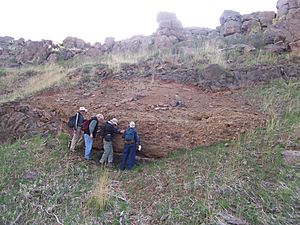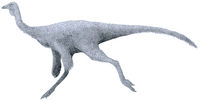Denver Formation facts for kids
Quick facts for kids Denver FormationStratigraphic range: Late Cretaceous-Paleocene |
|
|---|---|
| Type | Geological formation |
| Unit of | D1 Sequence |
| Underlies | Dawson Arkose |
| Overlies | Arapahoe Formation |
| Thickness | up to 1,580 ft (480 m) |
| Lithology | |
| Primary | Claystone, siltstone, sandstone |
| Other | Conglomerate, tuff, coal, lava |
| Location | |
| Region | Colorado |
| Country | United States |
| Type section | |
| Named for | Denver, Colorado |
| Named by | Emmons, Cross and Eldridge (1896) |
The Denver Formation is a special layer of rock found deep underground in the central part of the Denver Basin, right beneath the city of Denver, Colorado. This rock layer formed a very long time ago, from the late Cretaceous Period into the early Paleocene Epoch.
It's important because it contains clues about Earth's past. Scientists have found dinosaur bones and other fossils in the older parts of this formation. It also holds aquifers, which are underground layers of rock that store water, providing an important source of water for the people living in the area.
Contents
What is the Denver Formation?
The Denver Formation is a thick stack of rock layers. It sits on top of another rock layer called the Arapahoe Formation. You can tell where the Denver Formation begins because it's where you first see special volcanic ash rocks called tuff. Above the Denver Formation, you'll find the Dawson Arkose rock layer.
Scientists sometimes group the Denver Formation with other rock layers into a bigger unit called the D1 sequence. This helps them study the entire Denver Basin more easily, even though the rocks can change quite a bit from one place to another.
How Thick is it and What's it Made Of?

The Denver Formation was formed from sediments that piled up at the base of the growing Rocky Mountains. These sediments were carried by rivers, deposited in swamps, and formed fan-shaped piles of debris.
This rock layer can be quite thick, ranging from about 600 feet (180 m) to 1,580 feet (480 m) in the middle of the Denver Basin. It contains a lot of volcanic material, especially from a type of volcano called andesite.
The formation is mostly made of:
- Light-grey to brown claystone and mudstone (very fine-grained rocks).
- Siltstone (a bit coarser than claystone).
- Volcanic sandstone (sand-sized grains, often from volcanoes).
- Conglomerate (rock made of rounded pebbles and cobbles).
- Layers of low-rank coal and dark, carbon-rich shale can be found in the upper parts.
You can also find ancient lava flows in the upper part of the Denver Formation. These are visible at North Table Mountain and South Table Mountain near Golden, Colorado. These lava flows came from an ancient volcano, possibly from a place called the Ralston Dike. These rocks contain interesting minerals like augite, plagioclase, and olivine. One of the lava flows is famous for having many different types of zeolite minerals, which are beautiful crystals.
How Old is it and What Fossils are Found?
The Denver Formation is special because it covers the time of the Cretaceous-Paleogene boundary. This is the time when a giant asteroid hit Earth, causing the extinction of the dinosaurs.
The lava flows in the upper part of the formation are about 62 to 64 million years old. This means they formed in the early Paleocene Epoch. The actual boundary layer, which marks the dinosaur extinction event, has been found in the lower part of the formation on South Table Mountain.
Scientists have found many fossils in the Denver Formation:
- Plant fossils.
- Remains of vertebrates (animals with backbones) like turtles and early mammals.
- Dinosaur remains, but these are only found in the older, Late Cretaceous part of the formation, before the extinction event.
Dinosaurs of the Denver Formation
Scientists have found different types of dinosaurs in the Late Cretaceous part of the Denver Formation.
Ornithischian Dinosaurs
These are "bird-hipped" dinosaurs.
| Ornithischian Dinosaurs from the Denver Formation | ||||||
|---|---|---|---|---|---|---|
| Genus | Species | Location | Stratigraphic position | Material Found | Notes | Images |
|
Cionodon |
C. arctatus |
"Jawbone fragments, vertebrae, and other bone pieces." |
Later identified as general duck-billed dinosaur remains. |
|||
|
Not specified |
||||||
|
Not specified |
||||||
|
Polyonax |
P. mortuarius |
"Horn fragments, vertebrae." (This was the first fossil found for this type) |
A ceratopsian (horned dinosaur) whose exact type is uncertain. |
|||
|
T. galeus |
"Nasal horn core." |
A ceratopsian whose exact type is uncertain. |
||||
|
Not specified |
||||||
Saurischian Dinosaurs
These are "lizard-hipped" dinosaurs, including meat-eaters and long-necked plant-eaters.
| Saurischian Dinosaurs of the Denver Formation | ||||||
|---|---|---|---|---|---|---|
| Genus | Species | Location | Stratigraphic position | How Many Found | Notes | Images |
|
Aublysodon |
A. mirandus |
Later identified as general tyrannosaur remains (like T. rex). |
||||
|
O. velox |
||||||
|
Not specified |
||||||






